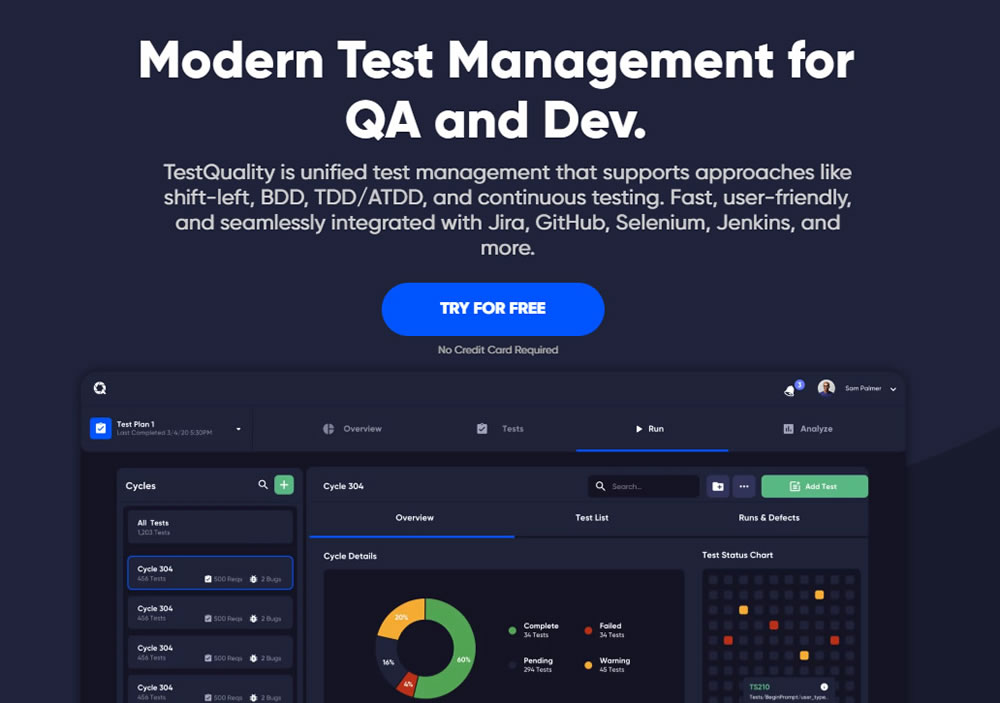This blog post is designed as a guide to illuminate the critical importance of software testing plans—a cornerstone in ensuring the delivery of reliable and high-quality software products as we described in a previous post when we described the process of creating a complete Test Plan.
For QA professionals and testers, as well as for those developers that are getting initiated on a journey into the world of testing, this post serves as a reaffirmation of our principles. Join us as we explore the essence of testing plans, dissect the key points for a winning test plan, craft them step by step, provide templates and examples, and unravel best practices for effective test planning.
1. Understanding the Essence of Software Testing Plans
In this point, we delve into the foundational aspects of software testing plans, elucidating their importance and role in the software development lifecycle.
1.1 Introduction to Software Testing Plans
Software testing plans serve as the blueprint for the entire testing process, outlining the objectives, strategies, and methodologies to ensure the delivery of high-quality software products. They provide a structured approach to testing, enabling teams to identify defects early, mitigate risks, and maintain the integrity of the software.
2.1 Importance of Software Testing Plans
- Quality Assurance: According to the World Quality Report 2021-22, inadequate testing processes account for 26% of software project failures. A robust testing plan helps mitigate these risks by ensuring thorough testing coverage and adherence to quality standards.
- Cost Reduction: Studies have shown that the cost of fixing defects increases exponentially as the project progresses. By detecting and addressing defects early through effective test planning, organizations can significantly reduce the overall cost of software development.
- Customer Satisfaction: High-quality software products are essential for maintaining customer satisfaction and loyalty. A well-executed testing plan helps identify and rectify issues before they reach the end-user, thereby enhancing the overall user experience.
3.1 Role of Testing Plans in the SDLC
Software testing plans play a crucial role at every stage of the software development lifecycle, from requirements gathering to deployment and maintenance. They provide clarity and direction to the testing process, ensuring alignment with project goals and objectives.
2. Key Components of a Software Testing Plan
This chapter delves into the essential components that constitute a comprehensive software testing plan, providing insights into each element's significance and purpose.
2.1 Test Objectives
Defining clear and measurable test objectives is paramount to the success of any testing endeavor. For example, a test objective could be to validate the functionality of a registration form on a website by ensuring that users can create accounts successfully without encountering errors.
2.2 Test Strategies
Test strategies outline the approach and methodologies that will be employed during the testing process. This may include techniques such as black-box testing, white-box testing, and exploratory testing, depending on the nature of the project and its requirements.
2.3 Test Scenarios
Test scenarios depict real-world usage scenarios that need to be tested to ensure the software's functionality, performance, and security. For instance, a test scenario for an e-commerce platform might involve simulating the process of adding items to a shopping cart, applying discounts, and completing the checkout process.
2.4 Test Schedule
The test schedule delineates the timeline for various testing activities, including test planning, execution, and reporting. It ensures that testing activities are conducted in a structured and organized manner, preventing delays and bottlenecks in the testing process.
3. Crafting a Test Plan: Step-by-Step Guide
In this chapter, we provide a comprehensive step-by-step guide to crafting a software testing plan, offering practical insights and tips for each stage of the process.
Step 1: Define Testing Objectives and Scope
Begin by clearly defining the objectives of the testing process and delineating the scope of the project. This involves identifying the features and functionalities that will be tested, as well as any specific requirements or constraints that need to be taken into account.
Step 2: Identify Testing Techniques and Tools
Once the objectives and scope have been defined, identify the testing techniques and tools that will be used to achieve them. This may include automated testing tools, performance testing frameworks, and security testing methodologies.
Step 3: Develop Test Cases and Scenarios
Next, develop test cases and scenarios based on the identified requirements and objectives. These test cases should cover all possible scenarios and edge cases, ensuring comprehensive test coverage and validation of the software's functionality.
In this sense, TestQuality empowers you to perform many test management actions:
- Run tests across environments: Ensure flawless functionality on all devices and browsers.
- Enhance Collaboration: QA and Dev teams are able to streamline communication and feedback within PRs. TestQuality facilitates discussions, knowledge sharing, and quality assurance leading to a more cohesive development team.
- Embrace test-driven development: Write tests first for a more efficient and reliable workflow.
See firsthand how PR testing can revolutionize your campaigns. Experience the difference and unlock the true potential of your PR efforts today!

Subscribe to TestQuality for a free 14-day trial
Step 4: Allocate Resources and Set Schedule
Allocate the necessary resources, including human resources, testing environments, and tools, to support the testing activities. Additionally, set a realistic schedule for the testing process, taking into account factors such as project deadlines, resource availability, and dependencies.
Step 5: Execute Tests and Monitor Progress
Execute the test cases and scenarios according to the established schedule, monitoring progress and identifying any issues or deviations from the expected outcomes. This may involve tracking defects, analyzing test results, and adjusting testing strategies as needed.
Step 6: Analyze Results and Report Findings
Once testing is complete, analyze the results and compile a comprehensive report documenting the findings, including any defects, issues, or areas for improvement. This report serves as a valuable resource for stakeholders, informing decision-making and guiding future testing efforts.
4. Test Plan Templates and Examples
In this section, we provide a collection of test plan templates and real-world examples to aid readers in crafting their own software testing plans.
4.1 Test Plan Templates
Introducing ready-to-use test plan templates can significantly expedite the test planning process and ensure adherence to industry best practices. For instance, Guru99 offers a comprehensive test plan template that covers all essential components, from objectives to schedules. In our future test plan template, we will find a user-friendly interface with customizable sections, perfect for teams seeking flexibility in their test planning approach. Utilizing these templates streamlines the documentation process, allowing teams to focus on testing rather than formatting.
4.2 Real-World Test Plan Examples
With regards to test plan examples, we could consider an e-commerce website test plan focusing on critical functionalities like user registration, product search, and checkout processes. By structuring test cases around these scenarios, teams can ensure thorough coverage and uncover potential issues before they impact end-users.
Similarly, a mobile app test plan might prioritize compatibility testing across different devices and operating systems, enhancing the user experience across diverse platforms. These real-world examples demonstrate how test plans translate theory into practice, driving tangible improvements in software quality.
4.2.1 - Example: E-commerce Website Test Plan
An example of a test plan for an e-commerce website could include test objectives such as validating user registration, product search functionality, and checkout process. It would outline testing techniques such as functional testing, usability testing, and security testing, along with a detailed schedule and allocation of resources.
4.2.2 - Mobile App Test Plan
For a mobile app, the test plan might include objectives related to compatibility testing across different devices and operating systems, as well as performance testing under varying network conditions. It would outline specific test scenarios for key features such as login, navigation, and data synchronization, along with a timeline for testing and deployment.
5. Best Practices for a Test Plan
This point explores best practices and strategies for optimizing the test planning process, ensuring efficiency, and effectiveness in software testing efforts.
5.1 Utilize Risk-Based Testing
Prioritizing testing efforts based on risk assessment is paramount to efficient test planning. According to Capers Jones, the cost of fixing defects detected during system testing is 100 times higher than those found during requirements and design stages. By focusing testing efforts on high-risk areas, teams can maximize test coverage and allocate resources effectively, reducing the likelihood of critical defects slipping through the cracks.
5.2 Promote Collaboration and Communication
A goal to achive when creating an effective test plan is to encourage collaboration among team members, including software developers, testers, and stakeholders, to ensure alignment of goals and objectives.

Besides, fostering collaboration among team members, stakeholders, and across departments enhances the effectiveness of test planning. Research in an older McKinsey report, showed that well-connected teams see a productivity increase of 20–25%.
Also, recent information on this subject comes from a report The State of Business Communication in 2023 conducted by the Harris Poll on behalf of Grammarly. That study shows that 72% of business leaders believe that effective communication has increased their team’s productivity, and 52% of knowledge workers agree.
5.3 Automate Testing Where Possible
Leverage automation tools and frameworks to streamline repetitive testing tasks and maximize efficiency. Automate regression testing, performance testing, and other routine activities to free up resources for more exploratory and creative testing efforts.
Without a doubt, automation plays a crucial role in streamlining testing processes and accelerating time-to-market. Capgemini's survey"The World Quality Report 2022-23" reveals that 48% of Technology, Media and, Telcoms teams achieved better reliability of systems through test automation and 49% of teams, achieved faster release times through test automation.
In conclusion and according to the mentioned Capgemini survey, test automation is usually more beneficial for teams who have an established Agile approach. Get the procedures right, set reasonable goals, have solid standards, and assemble a supportive team, and you'll enhance the frequency with which you reap the rewards necessary to thrive in the contemporary world. By automating repetitive tasks such as regression testing and performance testing, teams can focus on more exploratory and creative testing efforts, driving innovation and enhancing software quality.
5.4 Continuously Monitor and Adapt
Monitor testing progress and outcomes continuously, adjusting testing strategies and priorities as needed based on emerging issues or changes in project requirements. Stay agile and adaptable to respond effectively to evolving challenges and opportunities.
Agile methodologies emphasize the importance of continuous monitoring and adaptation throughout the development lifecycle. Research by McKinsey & Company shows that agile organizations are 70% more likely to have better organizational health. By monitoring testing progress and outcomes continuously, teams can identify emerging issues early and adapt their strategies to address evolving challenges, ensuring timely delivery of high-quality software products.
6. Integrating Test Planning into Agile and DevOps Workflows
As Agile and DevOps methodologies continue to gain prominence in the software development landscape, it's essential to adapt test planning processes to align seamlessly with these frameworks.
6.1 Agile Test Planning:
In Agile development, test planning occurs iteratively throughout the project, with short planning cycles known as sprints. According to the State of Agile Report 2021, 95% of organizations practice Agile development methodologies. By integrating test planning into Agile workflows, teams can align testing efforts with development iterations, promoting collaboration, and enabling rapid feedback loops, ultimately accelerating time-to-market and enhancing software quality.
6.2 DevOps Test Planning:
In DevOps environments, test planning is seamlessly integrated into continuous integration and continuous deployment (CI/CD) pipelines. The 2021 Accelerate State of DevOps Report highlights that high-performing DevOps teams deploy code 440 times more frequently and recover 96 times faster from failures. By automating test execution and incorporating testing into CI/CD pipelines, teams can achieve faster release cycles, increased deployment frequency, and improved software reliability, driving business value and competitive advantage.
Conclusion
As we conclude our exploration into the realm of software testing plans, it's evident that they are indispensable tools for ensuring software quality and reliability. For QA professionals, this guide serves as a reaffirmation of our principles and practices, while for developers, it offers invaluable insights into the world of testing. Together, let us embrace the power of effective test planning, elevating our testing endeavors and delivering software products of unparalleled quality.
TestQuality Test Management allows you to optimize and simplify the process of test plan creation. TestQuality provides a user-friendly interface that allows you to easily define test scope, assign resources, and schedule testing activities thanks to the effortless integration with GitHub and Jira.






